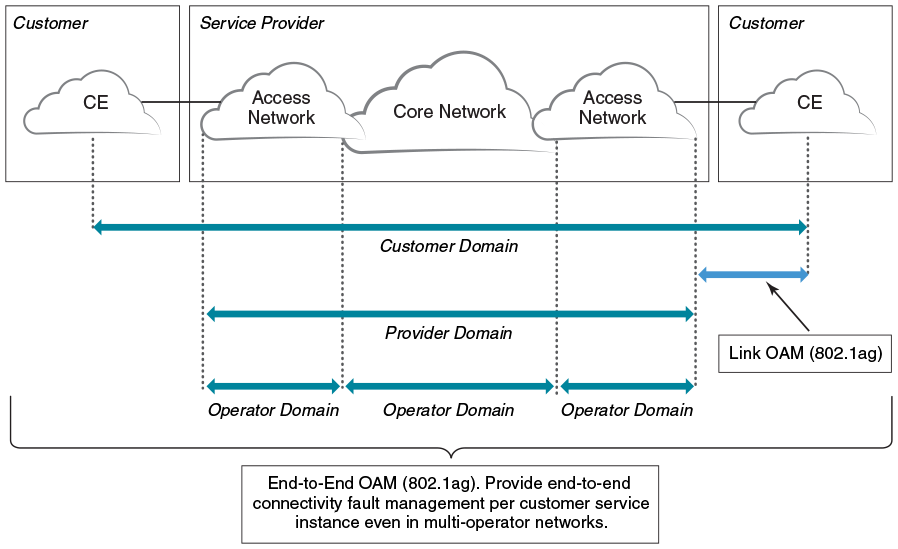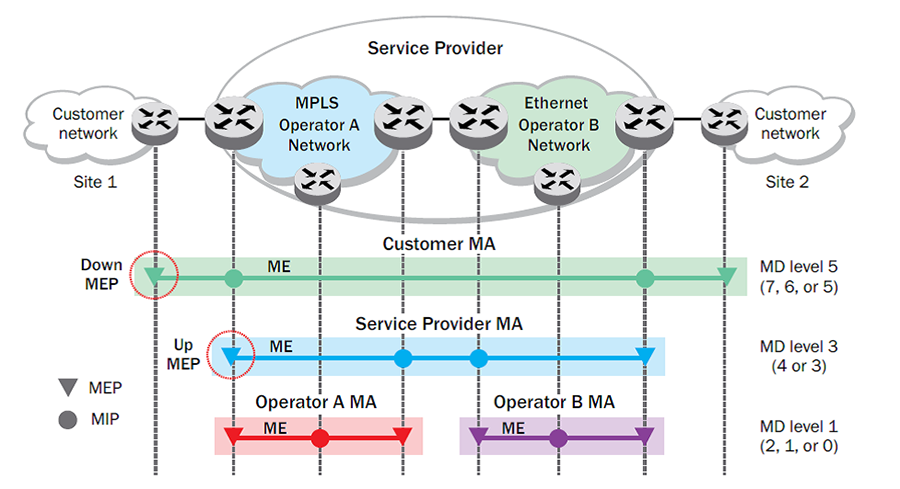802.1ag Connectivity Fault Management
Bridges are increasingly used in networks operated by multiple independent organizations, each with restricted management access to each other‘s equipment. CFM provides capabilities for detecting, verifying and isolating connectivity failures in such networks.
There are multiple organizations involved in a Metro Ethernet Service: Customers, Service Providers and Operators.
Customers purchase Ethernet Service from Service Providers. Service Providers may utilize their own networks, or the networks of other Operators to provide connectivity for the requested service. Customers themselves may be Service Providers, for example a Customer may be an Internet Service Provider which sells Internet connectivity.

Maintenance Domain (MD)
A Maintenance Domain is part of a network controlled by a single operator. In the following figure, a customer domain, provider domain and operator domain are described.
The Maintenance Domain (MD) levels are carried on all CFM frames to identify different domains. For example, in the following figure, some bridges belong to multiple domains. Each domain associates to an MD level.
• Customer Level: 5-7
• Provider Level: 3-4
• Operator Level: 0-2

Maintenance Association (MA)
Every MD can be further divided into smaller networks having multiple Maintenance End Points (MEP). Usually an MA is associated with a service instance (for example, a VLAN or a VPLS).
Maintenance End Point (MEP)
An MEP is located on the edge of an MA and defines the endpoint of the MA. Each MEP has unique ID (MEPID) within the MA. The connectivity in a MA is defined as connectivity between MEPs. MEPs generate a Continuity Check Messages that are multicast to all other MEPs in same MA to verify the connectivity.
Each MEP has a direction, down or up. Down MEPs receive CFM PDUs from the LAN and sends CFM PDUs towards the LAN. Up MEPs receive CFM PDUs from a bridge relay entity and sends CFM PDUs towards the bridge relay entity on a bridge. End stations support down MEPs only, as they have no bridge relay entities.
Maintenance Intermediate Point (MIP)
An MIP is located within a MA. It responds to Loopback and Linktrace messages for Fault isolation.
CFM Hierarchy
MD levels create a hierarchy in which 802.1ag messages sent by customer, service provider, and operators are processed by MIPs and MEPs at the respective level of the message. A common practice is for the service provider to set up a MIP at the customer MD level at the edge of the network, as shown in the figure above, to allow the customer to check continuity of the Ethernet service to the edge of the network. Similarly, operators set up MIPs at the service provider level at the edge of their respective networks, as shown in the figure above, to allow service providers to check the continuity of the Ethernet service to the edge of the operators‘ networks. Inside an operator network, all MIPs are at the respective operator level, also shown in the figure above.
Mechanisms of Ethernet IEEE 802.1ag OAM
Mechanisms supported by IEEE 802.1ag include Connectivity Check (CC), Loopback, and Link trace. Connectivity Fault Management allows for end-to-end fault management that is generally reactive (through Loopback and Link trace messages) and connectivity verification that is proactive (through Connectivity Check messages).
Fault detection (continuity check message)
Each MEP transmits periodic multicast CCMs towards other MEPs. For each MEP, there is 1 transmission and n-1 receptions per time period. Each MEP has a remote MEP database. It records the MAC address of remote MEPs.
Fault verification (Loopback messages)
A unicast Loopback Message is used for fault verification. A Loopback message helps a MEP identify the precise fault location along a given MA. A Loopback message is issued by a MEP to a given MIP along an MA. The appropriate MIP in front of the fault responds with a Loopback reply. The MIP behind the fault do not respond. For Loopback to work, the MEP must know the MAC address of the MIP to ping.
Fault isolation (Linktrace messages)
Linktrace mechanism is used to isolate faults at Ethernet MAC layer. Linktrace can be used to isolate a fault associated with a given Virtual Bridge LAN Service. Note that fault isolation in a connectionless (multi-point) environment is more challenging than a connection oriented (point-to-point) environment. In case of Ethernet, fault isolation can be even more challenging since a MAC address can age out when a fault isolates the MAC address. Consequently a network-isolating fault results in erasure of information needed for locating the fault.

